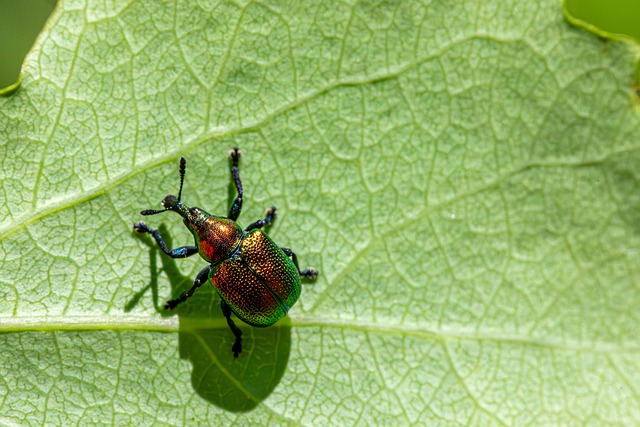Grain weevils pose a significant threat to properties if left unchecked. Early recognition of signs like holes in packaging and odors is crucial for professional removal. Control methods include chemical insecticides (with health risks), non-chemical alternatives, and eco-friendly solutions. Professional services employ organic pesticides, physical removal, storage improvements, and natural predators. Sanitation practices are key to reducing weevil populations. Selecting the right control service involves finding experts specializing in eco-friendly pest control for residential or commercial spaces, offering free inspections, customized plans, and ongoing monitoring.
Grain weevils can wreak havoc on stored grains and crops, causing significant damage to homes and businesses alike. Understanding these pests and their behavior is the first step towards effective control. This article delves into comprehensive strategies for eliminating grain weevil infestations, from identifying signs and causes to exploring traditional and eco-friendly pest control methods. We also provide valuable insights for choosing the right weevil control services, ensuring effective residential or commercial grain weevil management. Discover professional weevil removal solutions and learn how to safeguard your grains with the best practices in this guide.
Understanding Grain Weevil Infestations: Signs and Causes
Grain weevils can quickly turn into a significant pest problem for both residential and commercial properties if left unchecked. Understanding the signs and causes of an infestation is crucial in effective grain weevil control services. These small but destructive insects feed on stored grains, seeds, and dried plant matter, making them a common household and warehouse pest.
Recognizing the presence of grain weevils early is key to successful professional weevil removal. Signs include noticeable holes in packaging, peculiar odors, and tiny dark specks or larvae. These pests are most likely to infest areas with access to food sources like grains, nut products, and dried goods. Commercial weevil extermination often involves targeted treatments, ensuring that all infested zones are thoroughly decontaminated using eco-friendly weevil solutions. Prompt action and a comprehensive grain weevil infestation treatment plan are essential to restoring affected spaces and preventing future reinfestations.
Traditional Pest Control Methods for Grain Weevils
Traditional pest control methods for grain weevils often involve chemical insecticides designed to target and eliminate these pests. These chemicals can be effective in killing adult weevils, larvae, and eggs, but they come with drawbacks. Residential areas may require more cautious application due to potential health risks associated with exposure to pesticides, especially for families with young children or pets. Professional weevil removal services typically employ skilled technicians who understand the proper use and safety measures for these chemicals.
For those seeking eco-friendly alternatives, there are several non-chemical grain weevil control services available. These solutions focus on natural methods like heat treatment, cold storage, or the introduction of beneficial insects that prey on weevils. Commercial weevil extermination businesses often specialize in these eco-conscious tactics, catering to customers who prioritize environmental safety while managing infestations. Such methods provide effective grain weevil infestation treatments without resorting to harsh chemicals, making them ideal for both residential and commercial spaces.
Eco-Friendly Solutions for Effective Grain Weevil Management
Many homeowners and businesses opt for eco-friendly solutions when it comes to managing grain weevils, preferring methods that minimize environmental impact while effectively eliminating infestations. Professional weevil removal services often employ a combination of strategies such as organic pesticides, physical removal, and improved storage practices. These approaches not only target adult weevils but also their eggs and larvae, breaking the infestation cycle.
Grain weevil pest control experts may recommend using natural predators like mites or bacteria that are safe for humans and pets but harmful to the pests. Additionally, proper sanitation and storage techniques, such as storing grain in airtight containers and maintaining clean facilities, can significantly reduce weevil populations. Eco-friendly weevil solutions are not only effective but also promote a safer living environment, making them an attractive option for residential and commercial properties struggling with grain weevil infestations.
Choosing the Right Weevil Control Service: Tips for Residents and Businesses
When dealing with a grain weevil infestation, selecting the right control service is paramount. Residents and businesses should seek professional weevil removal experts who offer effective yet eco-friendly solutions. Look for companies specializing in grain weevil pest control, as these professionals have the knowledge and tools to address the specific challenges posed by this type of infestation.
Consider services that provide both residential weevil treatment and commercial weevil extermination, ensuring a tailored approach based on the scale and nature of your problem. Reputable firms often offer free inspections and customized plans, guaranteeing a thorough grain weevil infestation treatment. They may also provide ongoing monitoring and support to prevent future infestations.
Grain weevil infestations can be effectively managed and eliminated through a combination of traditional and eco-friendly methods. For severe or persistent cases, professional weevil control services offer specialized treatments like heat or cold therapy, baiting, and targeted spraying. Residents and businesses should consider reputable providers who utilize safe, eco-conscious techniques such as natural repellents, physical removal, and integrated pest management strategies to ensure a grain weevil-free environment without harmful chemicals. Timely intervention and the right control method are key to successfully treating and preventing future infestations.
